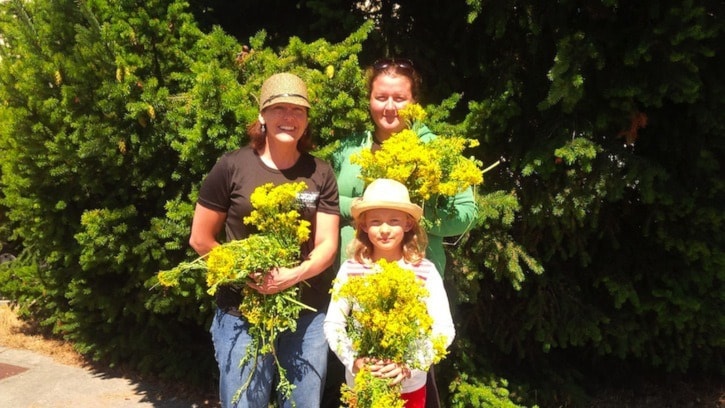A small group of Sooke’s farmers and members of the Sunriver Community Garden were pulling Tansy ragwort on Phillips Road on Sunday, August 3.
Tansy ragwort’s showy yellow blooms are easy to see this time of year and relatively easy to uproot. Volunteers took care to cut the flowers from the meter-high plants and put the flowers in bags as the uprooted plants might continue maturing the seeds.
According to the government of BC’s Field Guide to Noxious and Other Selected Weeds of British Columbia, Tansy ragwort “contains a toxic alkaloid which reacts with enzyme in livestock to create cumulative liver damage.”
Another ministry document, Weeds BC, adds that “Tansy ragwort reduces forage production of pastures by up to 50%.” A single plant can produce 150,000 seeds that remain viable for over 20 years. Tansy loves disturbed sites, including pastures, hay fields, roadsides and clear cuts. It is a major concern on Vancouver Island as well as in other places in B.C.
“We found Tansy ragwort on our farm last year for the first time,” noted David Parsons. David and Sandy Parsons raise Black Welsh Mountain Sheep on their Phillips Road farm. “I have been pulling ragwort since early spring in an effort to control it in our sheep pastures. I have also pulled the ragwort plants on Phillips Road from Willowpark Way north.”
The new owners of Cast Iron Farm (across Phillips Road from the Sunriver Garden) have been pulling the weed on their farm.
Volunteers worked to pull the flowering plants from Demamiel Creek north to Willowpark Way.
“Volunteers need not limit themselves to one day,” encourages Parsons. “Develop a habit to pluck the offending plants for the rest of the summer and a big difference will be seen by next year alone.”
Three main means of control are recommended by the Ministry of Agriculture. Prevention, meaning not to let the plant go to seed. Chemical control with the herbicide 2,4-D (use with caution and knowledge). And biological control such as the Cinnabar moth larvae and Tansy ragwort flea beetle.
For more information, visit http://www.agf.gov.bc.ca/cropprot/tansy.htm
With notes from David Parsons
